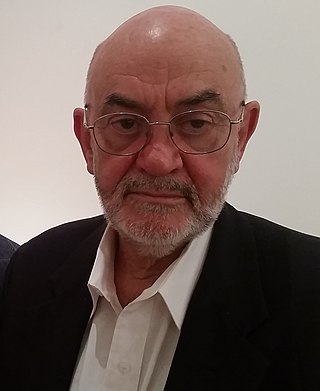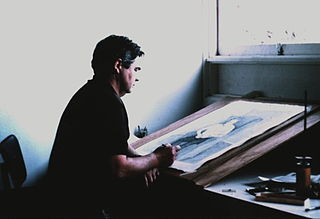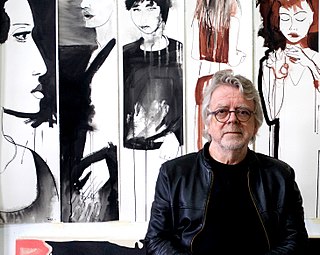
The National Gallery of Victoria, popularly known as the NGV, is an art museum in Melbourne, Victoria, Australia. Founded in 1861, it is Australia's oldest and most visited art museum.
Events from the year 1923 in art.

Rick Amor is an Australian artist and figurative painter. He was an Official War Artist for Australia.

John Brack was an Australian painter, and a member of the Antipodeans group. According to one critic, Brack's early works captured the idiosyncrasies of their time "more powerfully and succinctly than any Australian artist before or since. Brack forged the iconography of a decade on canvas as sharply as Barry Humphries did on stage."
Salon des Refusés is a popular Australian art exhibition which shows some of the rejected submissions to the Archibald Prize, Australia's most prestigious art prize for portraiture, and also the Wynne Prize entries for landscape & figure sculpture. The Salon des Refusés exhibition was initiated in 1992 by the S.H. Ervin Gallery in Sydney, in response to the large number of works entered into the Archibald Prize not selected for hanging in the official exhibition. Its name comes from a similar event that started in Paris in 1863, also called Salon des Refusés. S.H. Ervin Gallery is still the venue for Salon des Refusés.

Robert Lyall "Alfie" Hannaford, is an Australian realist artist notable for his drawings, paintings, portraits and sculptures. He is a great-great-great-grandson of Susannah Hannaford.

Ben Quilty is an Australian artist and social commentator, who has won a series of painting prizes: the 2014 Prudential Eye Award, 2011 Archibald Prize, and 2009 Doug Moran National Portrait Prize. He has been described as one of Australia's most famous living artists.
Georges Mora was a German-born Australian entrepreneur, art dealer, patron, connoisseur and restaurateur.
Bob Jenyns is a prolific Australian artist whose practice, spanning over four decades, has produced countless sculptures, prints, drawings, and paintings. He has participated in many of Australia's most significant art exhibitions including the first Biennale of Sydney (1973), the 1973, 1975 and 1978 Mildura Sculpture Triennials, the 1981 Australian Perspecta, the 2nd Australian Sculpture Biennale, and the 1990 Sculpture Triennial. Jenyns was a finalist in the 2006 Helen Lempriere National Sculpture Award, and in 2007 won the award with his work Pont de l'archeveche. He is represented in many of the country's largest collections, including the National Gallery of Australia, the Art Gallery of New South Wales, the Queensland Art Gallery, the Museum of Contemporary Art in Brisbane, and the Tasmanian Museum and Art Gallery. Jenyns has also received multiple grants from the Australia Council's Visual Arts Board, has curated exhibitions and has taught at the Tasmanian School of Art as head of the sculpture department (1982–2005).
Julie Rrap is an Australian contemporary artist who was raised on the Gold Coast in Queensland She was born Julie Parr, and reversed her name to express her sense of opposition. Since the mid-1970's she has worked in photography, painting, sculpture, video and performance. Julie's work expresses her interest in images of the body, especially the female body.
Peter Sebastian Graham is a contemporary Australian artist, painter, printmaker and sculptor. He was born in 1970 in Sydney, New South Wales. He moved with his family in 1983 to Melbourne, Victoria, where he currently lives and works.

Lina Bryans, was an Australian modernist painter.

Geoff Todd is an Australian artist and social commentator and has a contemporary figurative style in drawing, painting and sculpture. Geoff Todd works between studios in Winnellie, NT, and Ararat, Victoria.

Alan Constable is an Australian artist well known for his ceramic sculptural depictions of photographic cameras. Constable has worked principally from his Northcote-based studio at Arts Project Australia since 1991, gaining critical success as a multi-disciplinary artist proficient in a wide diversity of media including pastel, gouache, paint and ceramics. He has been working on his series of ceramic cameras since 2007 and works from this series were represented at the 2009 Australian Ceramic Triennale in Sydney and featured in a solo exhibition of his work, Clay Cameras, at the Centre for Contemporary Photography in Melbourne. Thirteen works from this series were acquired for the collection of the National Gallery of Victoria in 2014, and appeared in their blockbuster exhibition of contemporary art, Melbourne Now, in the same year.

Valerio Ciccone is an Australian artist who is best known for his drawings of mass-media events and icons taken from popular culture. He has worked from his Northcote-based studio at Arts Project Australia since 1984, where he has also had numerous solo shows. He has exhibited widely, both nationally and internationally [see Exhibitions] and his work is held in the collections of the National Gallery of Australia, Trinkhall Museum, Liège, and the National Sports Museum.
Pam Hallandal was an Australian artist, best known for her work in drawing and print making.
Julie Gough is an artist, writer and curator based in Tasmania, Australia.
Cristina Asquith Baker (1868–1960) was an Australian artist known for her paintings and lithographs. She studied with Frederick McCubbin, one of the key artists of the Australian impressionist Heidelberg school, but she was independent and did not tie herself to a single school of thought. She twice studied abroad, in Paris and London, gaining expertise in various other forms of artistic expression such as lithography and carpet-making.
Josephine Margaret Muntz Adams was an Australian artist who distinguished herself as a portraitist. Her portrait of Duncan Gillies, 14th Premier of the state of Victoria (1886-1890), hangs in Parliament House, Melbourne. Her portrait of the Queensland and Australian Federal politician Charles McDonald is in Parliament House, Canberra.
Jan Nelson is an Australian artist who works in sculpture, photography and painting. She is best known for her hyper real images of adolescents. She has exhibited widely in Australia as well as Paris and Brazil. Her works are in the collections of Australian galleries including the National Gallery of Australia, National Gallery of Victoria, Art Gallery of New South Wales, Museum of Contemporary Art, Sydney and the Gallery of Modern Art Brisbane, as well as major regional galleries. She represented Australia in the XXV biennale in São Paulo, Brazil.








